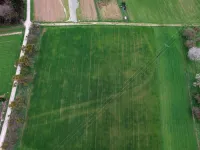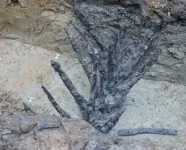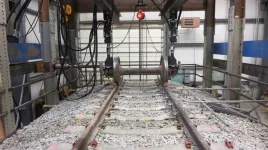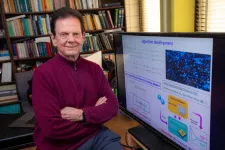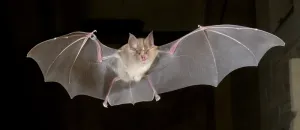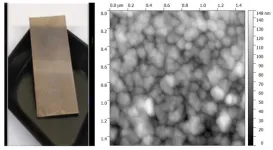(Press-News.org) When Prof. Markus Scholz, who teaches archaeology and the history of Roman provinces at Goethe University, returned to Bad Ems toward the end of the excavation work, he was astonished: After all, all the photos sent by his colleague Frederic Auth showed but a few pieces of wood. Not surprisingly, Scholz was ill-prepared for what he saw next: a wooden defense construction consisting of sharpened wooden stakes, designed to prevent the enemy’s approach. The martial-looking structure was intended to deter enemies from attacking the camp. Such installations – comparable, if you will, to modern barbed wire – are referenced to in literature from the time. Caesar, for instance, mentioned them. But to date, none had been found. The damp soil of the Blöskopf area obviously provided the ideal conditions: The wooden spikes, which probably extended throughout the entire downward tapering ditch around the camp, were found to be well preserved.
Two previously undiscovered Roman military camps
The work of the Frankfurt archaeologists and Dr. Peter Henrich of the General Directorate for Cultural Heritage of the German federal state of Rhineland-Palatinate, uncovered two previously unknown military camps in the vicinity of Bad Ems, situated on both sides of the Emsbach valley. The excavations were triggered by observations made by a hunter in 2016, who, from his raised hide, spotted color differences in the grain field, indicating the existence of sub-surface structures. A drone photo of the elevation, which bears the beautiful name "Ehrlich" (the German word for “honest”), confirmed the thesis: the field was crisscrossed by a track that could have originated from a huge tractor. In reality, however, it was a double ditch that framed a Roman camp. Geomagnetic prospecting later revealed an eight-hectare military camp with about 40 wooden towers. The archaeological excavations, carried out in two campaigns under the local direction of Dr. Daniel Burger-Völlmecke, revealed further details: the camp, apparently once intended as a solid build, was never completed. Only one permanent building, consisting of a warehouse and storeroom, was located there. The 3,000 soldiers estimated to have been stationed here probably had to sleep in tents. Burn marks show that the camp was burned down after a few years. But why?
It was the student team, led by Frederic Auth, that identified the second, much smaller camp, located some two kilometers away as the crow flies, on the other side of the Emsbach valley. The "Blöskopf" is no blank slate when it comes to archaeology: Exploratory excavations carried out in 1897 uncovered processed silver ore, raising the assumption that a Roman smelting works was once located there. The thesis was further supported by the discovery of wall foundations, fire remains and metal slag. For a long time it was assumed that the smelting works were connected to the Limes, built some 800 meters to the east at around 110 AD. These assumptions, considered valid for decades, have now been disproved: The supposed furnace in fact turned out to be a watchtower of a small military camp holding about 40 men. It was probably deliberately set on fire before the garrison left the camp. The spectacular wooden defense structure was discovered on literally the penultimate day of the excavations – along with a coin minted in 43 AD, proof that the structure could not have been built in connection with the Limes.
Roman tunnels located above the silver deposit
But why did the Romans fail to complete the large camp, instead choosing to abandon both areas after a few years? What were the facilities used for? Archaeologists have found a possible clue in the writings of historian Tacitus: He describes how, under Roman governor Curtius Rufus, attempts to mine silver ore in the area failed in 47 AD. The yield had simply been too low. In fact, the team of Frankfurt archaeologists was able to identify a shaft-tunnel system suggesting Roman origins. The tunnel is located a few meters above the Bad Ems passageway, which would have enabled the Romans to mine silver for up to 200 years – that is, if only they had known about it. In the end, the silver was mined in later centuries only. The Romans' hope for a lucrative precious metal mining operation also explains the military camp’s presence: They wanted to be able to defend themselves against sudden raids – not an unlikely scenario given the value of the raw material. "To verify this assumption, however, further research is necessary," says Prof. Scholz. It would be interesting to know, for example, whether the large camp was also surrounded by obstacles meant to hinder an enemy approach. So far, no wooden spikes have been found there, but traces could perhaps end up being discovered in the much drier soil.
Silver mining reserved for later centuries
The fact that the Romans abruptly abandoned an extensive undertaking is not without precedent. Had they known that centuries later, in modern times, 200 tons of silver would be extracted from the ground near Bad Ems, they might not have given up so quickly. The soldiers who were ordered to dig the tunnels obviously had not been too enthusiastic about the hard work: Tacitus reports that they wrote to Emperor Claudius in Rome, asking him to award the triumphal insignia to the commanders in advance so they would not have to make their soldiers slave away unnecessarily.
All considered, an exciting research story, which Frederic Auth, who has led the excavations in Bad Ems since 2019, also knows how to recount in an exciting way. His account won first prize in an interdisciplinary field of applicants at the 21st Wiesbaden Science Slam in early February. The young archaeologist is already booked for further appearances: Auth will perform in Heidelberg on March 2, in Bonn on March 7, and in Mannheim on March 19. More information about the events can be found at: https://www.science-slam.com/ (in German).
The research in Bad Ems was carried out jointly with the Directorate of State Archaeology in the General Directorate for Cultural Heritage of Rhineland-Palatinate, the Institute of Prehistory and Early History at the University of Erlangen-Nuremberg, and the Berlin University of Applied Sciences. Also involved were the hunter and honorary monument conservator Jürgen Eigenbrod and his colleague Hans-Joachim du Roi, as well as several metal detectorists with the necessary permits from the historical monument authorities. The project was financed with support from the Gerhard Jacobi Stiftung, the Society for Archaeology on the Middle Rhine and Moselle, and the German Research Foundation (Deutsche Forschungsgemeinschaft, DFG). The wooden spikes have meanwhile been preserved at the Römisch-Germanisches Zentralmuseum in Mainz.
Publication: A monograph on the archaeological excavations in Bad Ems is currently being prepared.
Images for download: https://www.uni-frankfurt.de/132551146
Captions:
Image 1: "Tractor Tracks". The excavations in Bad Ems were initiated by J. Eigenbrod, who spotted suspicious traces in the field from his high seat. The traces constitute changes in the vegetation, indicating ground interventions, in this case the ditches of the Roman camp on the "Ehrlich" (Photo: H.-J. du Roi)
Figure 2: The geomagnetic prospection confirms the assumption that traces of the former usage of the “Ehrlich” hill would be found under the fields in the soil. (Photo: C. Mischka, FAU Erlangen-Nuremberg).
Picture 3: The big surprise for the archaeologists unfolded during the last days of the excavation campaign: A construction of wooden spikes had been preserved in the damp soil of the "Blöskopf" hill, meant to deter potential attackers. (Photo: Auth)
Figure 4: Although Caesar had told of comparable obstacles meant to deter the enemy’s approach, so far no physical evidence of their existence had been found. For the most part, the wooden defensive constructions did not survive the test of the centuries. (Photo: Auth)
Figure 5: Winner among the interdisciplinary field of applicants at the 21st Wiesbaden Science Slam: Goethe University’s archaeologist Frederic Auth (3rd from left) with moderator Rainer Holl (from left) and science slammers Maria Bruhnke, Christopher Synatschke, Nina Lanzer and Uwe Gaitzsch. (Photo: science-slam.com)
Prof. Markus Scholz
Archaeology and History of the Roman Provinces
Institute for Archaeological Sciences, Department II
Goethe University
Tel. +49 (0)69 798 32265
Fax +49 (0)69 798 32268
E-Mail: m.scholz@em.uni-frankfurt.de
END
Hidden from the Romans: 200 tons of silver on the shores of the river Lahn
Goethe University’s Provincial Roman Archaeology department disproves previous assumptions during teaching excavation in Bad Ems
2023-02-21
ELSE PRESS RELEASES FROM THIS DATE:
Air pollution speeds bone loss from osteoporosis: Large study
2023-02-21
Elevated levels of air pollutants are associated with bone damage among postmenopausal women, according to new research led by scientists at Columbia University Mailman School of Public Health. The effects were most evident on the lumbar spine, with nitrous oxides twice as damaging to the area than seen with normal aging.
The research findings appear in the peer-reviewed journal eClinicalMedicine, part of The Lancet Discovery Science suite of open-access journals.
Previous studies on ...
Pain management pathway reduces use of opioids after urethral repair surgery
2023-02-21
February 21, 2022 – For men undergoing surgery to repair scarring in the urethra (urethroplasty), a new approach to pain management can reduce the need for strong opioid drugs without compromising pain control, reports a study in Urology Practice®, an Official Journal of the American Urological Association (AUA). The journal is published in the Lippincott portfolio by Wolters Kluwer.
"Over-prescribing of opioids for postoperative pain control has been a major contributor to the opioid epidemic,” comments senior author ...
CEE team helps DOD develop better analysis and design procedures for rail and roads
2023-02-21
CEE researchers will help the Department of Defense develop better systems to evaluate the structural health of rail lines and modernize pavement design and evaluation procedures in a new project funded by the U.S. Army Engineer Research and Development Center (ERDC) and led by Applied Research Associates Inc.
Within CEE, Professor Erol Tutumluer and Research Associate Professor J. Riley Edwards (MS 06, PhD 19) are leading the work for this multi-year research project called Advancing Power Projection through Lines of Communication (APPLoC). In the first year, the Department of Civil and Environmental Engineering will receive $2.1 million in grant funding.
As a whole, the ...
How to compensate for loss of gene function? Think alternative splicing
2023-02-21
Living organisms have a knack for persisting in the face of challenges. For instance, when genes malfunction, organisms may be able to compensate by activating redundant genes with similar functions, called paralogs.
One example of such compensation are two genes of the muscleblind-like (MBNL) family of RNA-binding proteins that lose their function in Myotonic Dystrophy Type 1, the most common cause of adult-onset muscular dystrophy. Loss of MBNL1 increases the levels of its paralog MBNL2 in tissues where protein expression is low, allowing MBNL2 to functionally compensate for MBNL1 loss. In animal models, loss of one paralog results in ...
Nguyen to receive NSF CAREER Award for NeuralSAT: A constraint-solving framework for verifying deep neural networks
2023-02-21
Thanhvu Nguyen, Assistant Professor, Computer Science, is set to receive funding for the project: "CAREER: NeuralSAT: A Constraint-Solving Framework for Verifying Deep Neural Networks."
Deep Neural Networks (DNNs) have emerged as an effective approach to tackling real-world problems. However, just like traditional software, DNNs can have bugs and be attacked. This naturally raises the question of how DNNs should be tested, validated, and ultimately verified to meet the ...
Pathak and Simon studying airborne and vehicular millimeter-wave wireless networking
2023-02-21
Parth Pathak, Associate Professor, Computer Science, and Robert Simon, Professor, Computer Science, received funding for the project: "Airborne and Vehicular Millimeter-wave Wireless Networking."
Pathak and Simon are developing a state-of-the-art unmanned aerial vehicle (UAV) and unmanned ground vehicle (UGV) mmWave wireless networking and computing software/hardware platform at George Mason University. The platform will consist of battery-powered and gas-electric hybrid hexacopters, vehicular nodes, and ground robots that will be augmented with mmWave ...
Researchers turn to quantum computing power to simulate, study atomic nuclei
2023-02-21
AMES, Iowa – Let’s see, thought James Vary, how can we have a little fun with the name of our $1 million nuclear physics project?
Hmm, can we work in the term hack?
So, it’s “Nuclei and Hadrons with Quantum Computers.” Or, “NuHaQ,” for short.
“It’s a takeoff on ‘hack,’” said Vary, an Iowa State University professor of physics and astronomy and leader of a new project supported by a three-year, $1 million grant from the U.S. Department of Energy. In academic computing circles, “to be a good hacker is a positive compliment. Hackers ...
Speaking up and getting results: New research identifies who employees should talk to at work
2023-02-21
INFORMS Journal Organization Science New Study Key Takeaways:
Choosing who to speak to greatly impacts how ideas are heard and implemented in the workplace.
Employees who speak to managers or bosses who have the authority and resources to address an issue, led to a 12%-15% increase in implementing ideas and subsequent sales performance.
Speaking to peers was associated with a 10% decrease in implemented ideas and subsequent sales performance.
BALTIMORE, MD, February 21, 2023 – Is speaking up at work worth it? New research in the INFORMS journal Organization Science finds that new ideas can be heard and implemented in the office, but it depends on who employees talk to.
“There ...
First stem cells from a bat species known to harbor SARS-CoV-2 could shed light on virus survival and molecular adaptability
2023-02-21
Researchers from the Icahn School of Medicine at Mount Sinai have generated the first induced pluripotent stem cells (iPSCs) from bats, gaining valuable insights into the close relationship between bats and viruses. This research opens the door to studying how viruses like SARS-CoV-2, which causes COVID-19, survive, spread, and evade the immune system through molecular adaptations to new hosts.
The team’s findings, published February 21 in Cell, may also shed light on the unique properties of bats that underlie their remarkable defenses against aging and cancer.
“Our study suggests that bats have evolved mechanisms to tolerate a large ...
Enhanced arsenic detection in water, food, soil
2023-02-21
WASHINGTON, Feb. 21, 2023 – It is a cruel paradox that on a planet with a surface mostly covered by water, hundreds of millions of people don’t have access to clean drinking water. As for the pollution of potable and natural water sources, one of the main culprits is arsenic, an abundant and toxic element in the earth’s crust. Arsenic is currently known as the cause of groundwater contamination in more than 100 countries – and can produce life-threatening diseases, especially for populations in developing ...
LAST 30 PRESS RELEASES:
Scientists boost cell "powerhouses" to burn more calories
Automatic label checking: The missing step in making reliable medical AI
Low daily alcohol intake linked to 50% heightened mouth cancer risk in India
American Meteorological Society announces Rick Spinrad as 2026 President-Elect
Biomass-based carbon capture spotlighted in newly released global climate webinar recording
Illuminating invisible nano pollutants: advanced bioimaging tracks the full journey of emerging nanoscale contaminants in living systems
How does age affect recovery from spinal cord injury?
Novel AI tool offers prognosis for patients with head and neck cancer
Fathers’ microplastic exposure tied to their children’s metabolic problems
Research validates laboratory model for studying high-grade serous ovarian cancer
SIR 2026 delivers transformative breakthroughs in minimally invasive medicine to improve patient care
Stem Cell Reports most downloaded papers of 2025 highlight the breadth and impact of stem cell research
Oxford-led study estimates NHS spends around 3% of its primary and secondary care budget on the health impacts of heat and cold in England
A researcher’s long quest leads to a smart composite breakthrough
Urban wild bees act as “microbial sensors” of city health.
New study finds where you live affects recovery after a hip fracture
Forecasting the impact of fully automated vehicle adoption on US road traffic injuries
Alcohol-related hospitalizations from 2016 to 2022
Semaglutide and hospitalizations in patients with obesity and established cardiovascular disease
Researchers ‘listen in’ to embryo-mother interactions during implantation using a culture system replicating the womb lining
How changing your diet could help save the world
How to make AI truly scalable and reliable for real-time traffic assignment?
Beyond fragmented markets: A new framework for efficient and stable ride-pooling
Can shape priors make road perception more reliable for autonomous driving?
AI tracks nearly 100 years of aging research, revealing key trends and gaps
Innovative techniques enable Italy’s first imaging of individual trapped atoms
KIER successfully develops Korea-made “calibration thermoelectric module” for measuring thermoelectric device performance
Diversifying US Midwest farming for stability and resilience
Emphasizing immigrants’ deservingness shifts attitudes
Japanese eels, climate change, and river temperature
[Press-News.org] Hidden from the Romans: 200 tons of silver on the shores of the river LahnGoethe University’s Provincial Roman Archaeology department disproves previous assumptions during teaching excavation in Bad Ems
